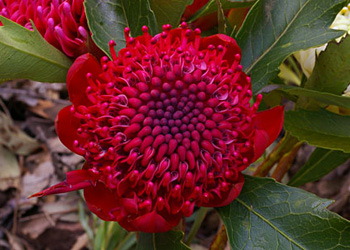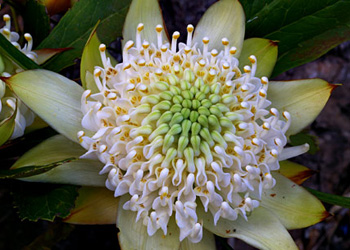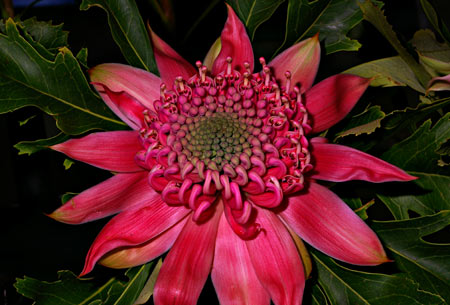
Growing the Sydney Waratah
Max Hewett
Experience indicates there are certain guidelines to the production of healthy specimens of waratah, Telopea speciosissima, under a wide range of soil types. The following factors are to be considered, the first four being of major significance.
1. Freedom from Root Competition
The late Frank Stone, founder of Waratah Park. Bilpin, maintained that anybody could grow waratahs providing they maintained the soil adjacent to the plant in a state of fine tilth. I have personally tested his statement on many occasions in my garden and confirm its accuracy.
After plants have been established two years or so and have formed a lignotuber, I have cultivated to shovel depth (approximately. 200 mm) from the plant stem to 1 metre radius. This has been done approximately twice per year and the plants have never failed to respond with new vigour and new growth at or near ground level. Plants not so treated have declined in vigour to bare stems carrying few leaves and few, if any, flowers. Some plants which had been overgrown with foliage from adjacent shrubbery and had been dormant for ten years or more have responded with new growth when freed from leaf competition and given the above soil treatment.
2. Depth of Soil to Impenetrable Layer
Waratahs are most successfully grown where the main root stem can penetrate freely to a metre or more (refer also Item 4 below). Although I have observed specimens growing and flowering in a bed made up of about 150 mm depth on a shelf rock, almost daily watering was required.
 |
|
 |
Telopea speciosissima. The red form (left) and the form known as 'Wirrimbirra White' (right)
Photos: Brian Walters |
3. Soil Type
Although specimens occur widely in the Hawkesbury Sandstone country of the Sydney area, the standard of foliage and flower development, except after fires followed by heavy seasonal rains, does not approach the quality of stands in the rich basaltic loams at Bilpin and other Blue Mountains areas, the deep brown loams with laterite association found near Terry Hills, or the brown loams on shale in some locations along the Putty Road north of the Colo River. In the deep, rich brown, volcanic loams of the Dandenongs near Melbourne, the Sydney waratah is grown extensively and to perfection for the cut flower trade. In the poorer soils near Melbourne, however, few satisfactory growings have been achieved. I had several reports of specimens flourishing in the volcanic loams of North Island, New Zealand, producing up to 100 flowers per plant.
From the above it would seem to be obvious that soils of the heavier texture offer the most likely condition for vigorous growth. In fact, gardeners in rich soil areas such as Wahroonga have little difficulty in establishing healthy plants, whereas those in sandy areas are frequently disappointed with their performance. This must be related to factors 4 and 6 (below) and suggests that plants grown in lighter soils should have their nutrient and moisture supply augmented for best results.
4. Availability of Soil Moisture and Drainage
One-time native plant nurseryman, Jack Twyford of Thornleigh, who grew waratahs very well in heavy clayey loam, made the following comment to me: "Waratahs do best when roots are kept cool and foliage is in full sun". My own experience would seem to confirm this. I believe in this regard that ideal conditions prevail where an impenetrable layer as noted in Item 2 provides the moisture trap, but a word of caution would be appropriate. Ensure that drainage of subsoil is adequate to prevent waterlogging in prolonged wet periods.
Although the species seems to be relatively resistant to attack by root fungus (Phytophthera cinnamomi), I have observed several plants in members' gardens which gave the appearance of such fungal attack. These were all in light soil areas over sandstone, and one might presume that subsoil drainage could be locally deficient. Perhaps the faster penetration of water through sandy soil and consequent raising of water table could represent a hazard.
 |
A number of cultivars of Telopea speciosissima are being developed, such as this unnamed pink form.
Photo: Brian Walters |
5. Aspect and Exposure
Despite comments in Item 4 above, I have grown and otherwise observed many plants growing reasonably in broken sun, so I feel this factor is only of minor significance. One member reported cases of leaf scorch, which perhaps could be attributed to his rich subsoil with ample subsoil moisture producing lush early growth with vulnerability to hot early seasonal conditions.
6. Fertilising
Although I personally do not use fertilisers on my waratahs, my earlier observations of members' gardens indicated favourable response to light applications. As noted in Item 3, the major necessity arises in gardens in the light soil range. The time for application is when new growth first appears in August.
7. Mulching
I find a heavy mulch of leaf litter advantageous providing the lignotuber is kept free and open. The mulch is dug in when cultivating (refer item 1).
8. Pruning
Established plants benefit greatly from pruning. As a general rule, early cutting of the flower stems to at least half the pre-flowering growth increases the number of flowering stems for the following year. Where mature plants have aged to a number of long bare canes, it is advantageous to cut them away completely to the lignotuber immediately after flowering. Some growers may be apprehensive of removal of all canes simultaneously. While I have not experienced ill effects from this treatment, I appreciate their concern and suggest, as a first up, the operation could be spread over two seasons.
9. Watering
The subject of soil moisture is reasonably covered above. If. however, hand watering is applied, I would suggest the object should be to restore subsoil moisture when dry seasons would affect growth in the growing period, and would best be achieved with infrequent heavy soakings by the trickle method. On the other hand. no adverse effect could be expected from occasional general garden waterings. Waratahs go into dormancy in Sydney in late autumn and commence new growth generally in early August (refer Item 6) ). Watering should not be applied during this period, unless only of a light nature.
10. Insect Attack
On certain plants in my garden insect attack to the flower buds occurs regularly each year. This I believe is from what is known as the Waratah Beetle, and has the effect of reducing the number of developed flowers on affected plants by up to 50%. All my efforts to date to overcome this problem have been in vain, the buds having been damaged before the attack was noticed.
The late Max Hewitt was one of the most knowledgeable and experienced growers of a wide range of Australian plants, including many regarded as 'difficult'. He was the leader of the Verticordia Study Group up until the time of his death in 2007. This article was first published in the Society's journal Australian Plants, September 1982 issue.
Australian Plants online - 2008
Association of Societies for Growing Australian Plants
|